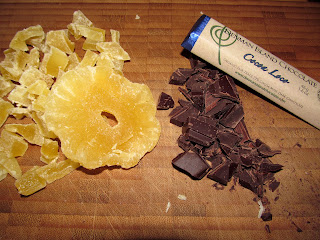"OMG help! My friends coming for lunch tomorrow and she's VEGAN!"
DON'T PANIC! It's not as hard as you think.
I know a lot of cooks who panic at the thought of cooking vegan. I know I use to. Even the though of cooking vegetarian use to make my knees turn to unset jelly (the one derived from seaweed of course ;). I would worry for days and days, go out and buy huge packs of exotic foods that I really don't enjoy, like Tofu, or non-meat-ground-beef. It was very expensive and, as I know now, unnecessary.
What does it mean to eat vegan? It means that they don't consume animal products. In fact, vegans are very careful not to use animal products in any way. This means everything from not eating meat to not wearing wool socks and a whole world of things in between Some people are vegans for ethical reasons (they love animals a lot and don't want them to be hurt in any way), some for medical reasons (extreme reactions to animal proteins would be one example), and some for a mixture of both reasons. I'm sure there are other important reasons as well, I just don't know them yet.
Now, it's kind of obvious that I am not a vegan. I'm not even vegetarian, although I do have a restricted diet due to health issues. But I do have friends who are, and like most of my friends, they tend to suddenly appear at meal times. I hate for a friend to go hungry.
As part of my goals for 2013, I am looking forward to posting some blog entries and recipe ideas for when our vegan friends come for lunch.
Here are some ideas that I've learned over the years...
- Veganism is more than just dietary choice or even a lifestyle choice. It takes dedication beyond what most people can imagine to live a vegan life, especially in this Carnivore-centric Western World of ours. It requires almost religious devotion to be vegan, and even if you don't understand their choices, you should respect how hard they work and how strongly they believe in what they do. I really admire someone who can live their life 100% in accordance with their values.
- If you don't know what to do when cooking for a vegan, the first step is to ask them questions! Vegans are some of the most understanding people in the world, they know that many of us don't know a darn thing about veganism. Sadly, vegans also know what it is like to be picked on - and because of this, are more interested in spreading the love, not encourage hate. I've never met a vegan who was down right hostile towards ignorance. They love to educate people about vegan life. They also tend to be highly educated in diet and nutrition. Your vegan friend is guaranteed to have a couple of quick and easy recipes hidden up a sleeve somewhere that they can recommend you make. You just have to ask.
- Turn it into a pot luck lunch. That way you don't have to worry about all the dishes, make some simple rice, maybe a chopped veg platter, and get them to bring a main course.
- When in doubt make hummus! Hummus can be made quick and easy with a can of chickpeas (drained), a few glugs of lime/lemon juice, garlic, olive oil and a blender. Hummus and crackers, hummus and raw veg cut up, hummus and bread...
- Chickpeas are your friend. There is no end of things you can do with a can of chick peas, most of them legal in Canada. It's my go to emergency food for guests and I always keep a dozen cans or so in my pantry at any given time. Oh, and even good quality canned chick peas are super-cheap. Mix them with an onion, garlic, potatoes, curry paste (check the ingredients list, I think Pataks mild curry is vegan friendly), and slow cooker, serve with rice and chutney. Your friend will never leave.
- Get a vegan cook book. You will be surprised how often you use it. It's also a great thing to have if you or a loved one has allergies and need advice on ingredient substitution. My copy of Vegan a Go-Go!
gets used all the time, it even has an awesome emergency toothpaste recipe or two for vegans on the a go-go.
- Not all vegan food is tofu. There is a lot more to veganism than soy products. People with soy allergies can enjoy the same meal as a vegan, it just takes a little co-ordination.
- Keep your meat in a separate part of the fridge. This is just common sense for anyone as it helps avoid contamination and food poisoning. Most fridges now have a special drawer just for meat. Not everyone is worry about meat and vegan food being stored in the same area, but some people find it very important. Better safe than having a guest vomit in disgust. Treat it the same way you would an extreme allergy. If you often have vegan or vegetarian friends to lunch, it would be worth dedicating a shelf in the fridge to non-animal products (that's no butter, no eggs, no milk, no meat, no cheese... &c.)
- Get a vegan friendly hand soap for the bathroom, a nice olive oil soap is always good, it's also very good for the skin. It's such a small thing, but it makes a big difference to making your friend feel at home.
- Don't serve meat at the same meal. There are some exceptions of course, like family traditions, and certain restaurant situations. Sometimes a vegetarian or vegan will say it's fine to eat meat in front of them, but it's more likely to make you both uncomfortable. Eat something vegetarian or vegan now and if you really, really have to, you can pig out on meat the next meal.
- You don't need to panic and buy fancy ingredients that you have no idea how to cook, or worse, try and impress with some complicated recipe that is going to take all your energy and time away from your friend. They came to spend time with you, not sit idle while you curse your kitchen and learn how to use a fire extinguisher.
- Vegetarian and vegan food does not have to taste like meat. In fact, there are so many yummy foods you can make without meat that I don't know why anyone would want to chow down on meat flavoured soy crud (no offence meant to the people who like meat flavoured soy crud).
- Try Indian food. Lots of meat free recipes there, although some need to be altered to avoid butter, cheese, &c. in order to be transformed from vegetarian to vegan friendly.
I have learned a lot about cooking by making lunch for my vegetarian and vegan friends. I've tried things I never thought I would and ended up adding them to my everyday recipe list.
So, you see, there is no need to panic. When in doubt, google 'vegan friendly restaurants (your towns name here)'. They will understand.
A few vegan friend recipe ideas:
Kimchi fried rice
Namuru - nice side dish you can make with chard, spinach, or other greens, that doesn't taste like semi-digested rabbit poo.
Turmeric Rice - use dashi made from seaweed
Yummy Lentils - Make sure you use vegan friendly soup stock
ps. Vegetarian and vegan diets are not really the same thing.
There are literally thousands of different vegetarian diets, anywhere from your lax vegetarian who does not eat beef most of the time, to someone who will eat no meat or anything that might grow up to be an animal (like an eggs) but is willing to eat animal bi-products like milk and cheese. When you are cooking for your vegetarian friend, make sure you talk to them and ask them about what they eat and do not eat. Treat it like you would an allergy, don't be an ass and try and sneak things by them. You wouldn't put peanut butter in someone's dinner if they were deathly allergic would you now?
Vegans are more strict about avoiding all animal products. I think of them as super-extreme-vegetarians-superhero-people! Which I know is a very long phrase and does not do justice to how cool they are. But it's meant with love.
pps. In this blog I often use the phrases 'vegan friendly' or 'not vegan friendly'. I'm not trying to be exclusive or mean or scare off vegans (or anyone else) in any way. I use these phrases because in my head, I associate the word vegan with the word friendly. I'm also trying to inform people who are not use to cooking for vegans weather a recipe is appropriate to serve to their vegan friends.








































